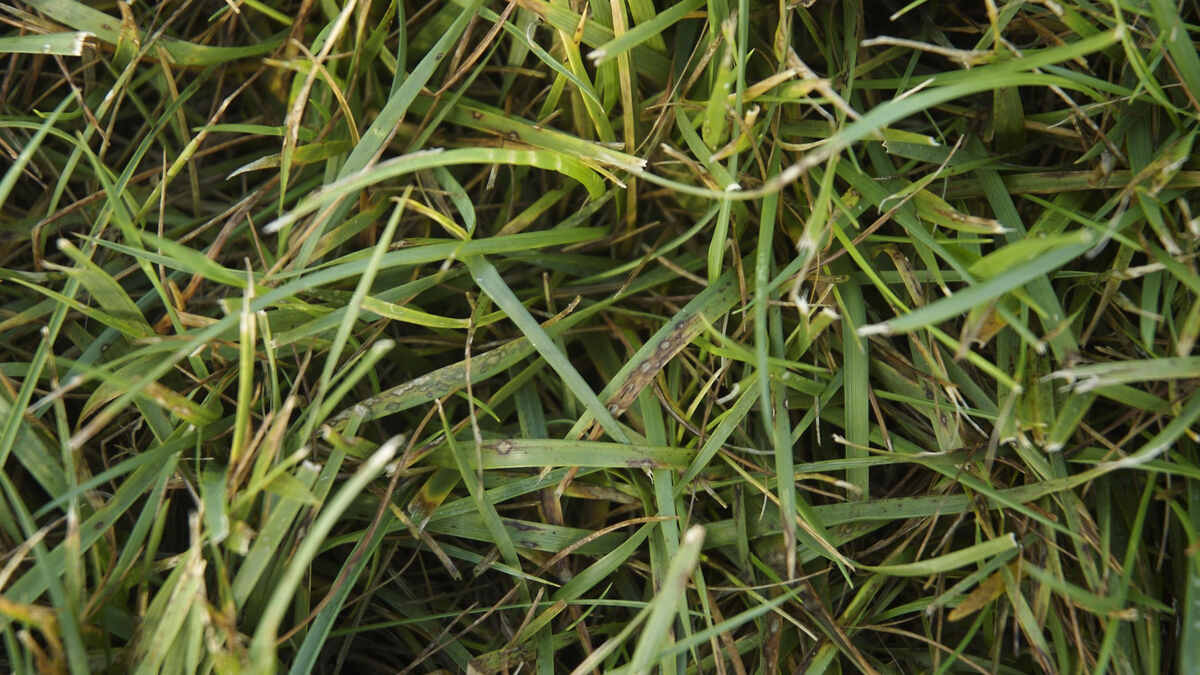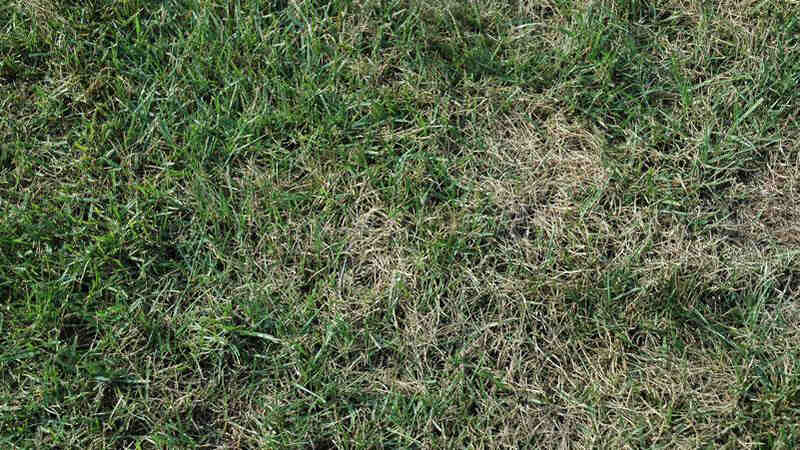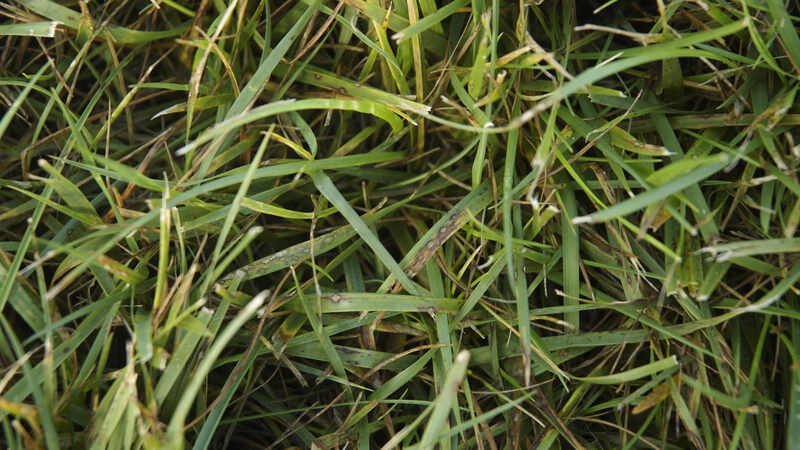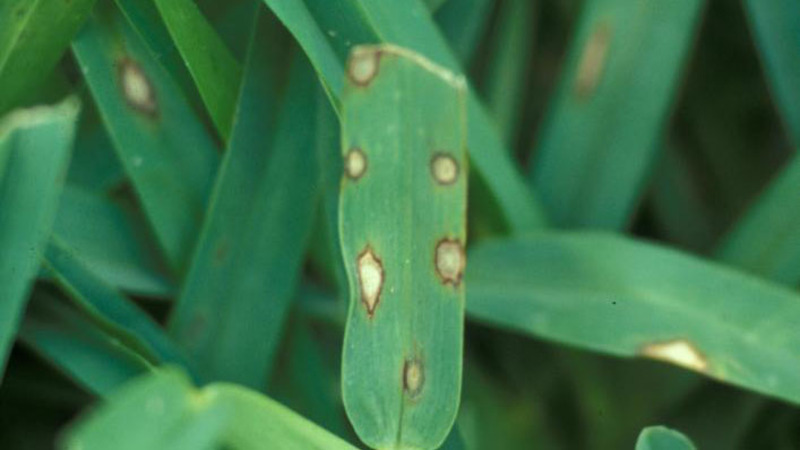
Gray leaf spot lawn disease (GLS) is a fungal infection that turns your turf thin and grayish and kills the grass if left unchecked. It’s a major threat to perennial ryegrass but also damages tall fescue and St. Augustinegrass. You can test for it at home, and proper lawn care practices are essential for limiting damage. But this nasty disease can be defeated only by adding fungicides into the mix.
Read this guide to learn gray leaf spot triggers and tell-tale signs, how to test a grass sample and prevent infection, and which fungicides to use.
- How to Recognize Gray Leaf Spot in Your Lawn
- How to Test for Gray Leaf Spot at Home
- How to Care for Your Lawn During Gray Leaf Spot Infection
- How to Control Gray Leaf Spot With Chemicals
- How to Repair Your Lawn After Gray Leaf Spot
- How to Prevent Reinfestation of Gray Leaf Spot
- How Does Gray Leaf Spot Infect and Damage Grass?
- Environmental Factors That Support Gray Leaf Spot
- FAQ About Gray Leaf Spot
How to Recognize Gray Leaf Spot in Your Lawn

GLS is easier to defeat if treated in a timely manner, but its symptoms are often similar to other common lawn diseases, some of which are milder and easier to combat. Lawn owners often underestimate the danger. Here’s what signs to look for in your turf and how to know it’s GLS and not something else.
- Small water-soaked spots: Initially, the infestation manifests through small, dark green to brown water-soaked spots on leaf blades, sheaths, and stems. Lesions develop a purple border, and the area around them turns yellow.
- Oblong spots on leaves, sheaths, and stolons: Lesions evolve into round or elongated spots that look scorched. They can be tan, olive green, and light brown in color with a necrotic dark brown border.
- Fuzzy gray growths: The GLS tell-tale is the felt-like growths, gray in color, appearing on the leaf spots when sporulation happens. It’s what gives the disease its color and name.
- Velvet-like gray covering the affected areas: Spore growths multiply in time. A specialized mycelial structure called a sporophore keeps hundreds of spores covering the infected leaves when the disease is the most active. It looks like a velvet, soft, gray layer.
- Blighted leaves with twisted tips: Leaf spots coalesce, covering the entire leaf and giving it a blighted look. In taller mowed turf, tips twist like fish hooks.
- Thinned, off-colored turf: Infestation extends from blade to blade. Sometimes it attacks the grass crown, and plants decay and die. From a distance, you’ll see thin, off-colored grass, similar to drought-stressed turf, with or without a blue-gray overcast.
Turfgrass Types Susceptible to Gray Leaf Spot
GLS attacks both warm-season and cool-season grasses. Fortunately, its damage is limited to only a few species, and there are resilient grass types you can replace or overseed with if necessary, such as Kentucky bluegrass and creeping bentgrass.
Warm-season grasses susceptible to gray leaf spot:
- St. Augustinegrass (Stenotaphrum secundatum)
- Kikuyu grass (Pennisetum clandestinum)
- Occasionally, GLS might affect centipedegrass and Bermudagrass but with much less damage.
Cool-season grasses susceptible to gray leaf spot:
- Perennial ryegrass (L. perenna) is the most damaged by GLS, with Linn, Premier, and Pinnacle being its most susceptible cultivars.
- Tall fescue (Festuca arundinacea)
The most severe outbreaks take place in newly germinated and established turf. Studies show grass has the highest susceptibility in the first 4 to 5 weeks after emergence. Gray leaf spot mainly attacks lawns under 1-year-old in suitable environmental conditions (humidity and high temperatures).
Established lawns over one year old see less damage and recover faster unless stressed by factors such as:
- Soil compaction
- Over-fertilization with nitrogen
- Improper irrigation practices
- Summer applications of the herbicide atrazine
- Nutrient deficiency in the soil
- Infestation with other pathogens or pests
- Grown in a shady, dark location
- Exposed to unusually long periods of warm, wet weather
Other Diseases You Can Confuse With GLS
Different fungal disease symptoms are similar and can easily be confused. Here are a few lawn problems often confused with GLS and how to tell them apart.
Drought Stress
In its early stages, gray leaf spot can look like a lawn under drought or heat stress. To ensure it’s not GLS:
- Check the soil for moisture and compaction. If the soil is dry and hard, your grass is probably drought-stressed. Take care of a drought-stressed lawn by mowing it higher than usual, suspending fertilization, and watering more often.
- If you’re still unsure, take a sample of soil and grass and test it.
Pythium Blight
The later signs of gray leaf spot can make you think it’s Pythium blight, another lawn disease active during summer. Pythium blight causes small circular patches, 2 to 6 inches wide, with withering, blackened, or reddish-brown grass. Its tell-tale sign is a cottony white mycelium you can spot on the soil surface early in the morning. The white mycelium is missing if it’s GLS in your turf.
Root Anthracnose
You can misidentify GLS in perennial ryegrass as root anthracnose since the stem base tissue often takes a dark brown tinge. If it is root anthracnose, leaf blades won’t show any individual lesions but will look blighted, with the entire leaf turning an orange-to-yellow tint. Grass sheaths and stolons can also be damaged.
Brown Patch
With similar lesions on the leaves to the ones caused by gray leaf spot, brown patch causes small irregular brown patches in your lawn with sunken centers up to a few feet in diameter.
The center often recovers in light infestations, making areas look like rings or arcs known as “frog eyes.” With GLS, it’s rare to see a frog-eye shape since most of the damaged grass doesn’t recover.
Brown patch infestations also come with whitish fungal threads covering the soil and grass, which are missing with GLS.
How to Test for Gray Leaf Spot at Home
The best way to know whether or not you’ve got GLS on your turf is to test it.
For a DIY test, start by taking a cup-cutter sample from a part of the lawn showing damage. Put it in a plastic bag. If the sample is dry, spray some plain water mist inside. Close the bag and leave it overnight in a dark, mildly warm place. If there is GLS fungus, you’ll see a gray mold develop by the next morning.
You can also:
- Send the sample to a plant pathology lab for testing.
- Contact a local lawn treatment expert to check and diagnose the diseased turf.
Whatever method you choose, make it fast. You must find out as soon as possible if it’s GLS so you can start proper treatment.
How to Care for Your Lawn During Gray Leaf Spot Infection

Finding out you have gray leaf spot disease in your lawn does not make a good day. But don’t worry. Even with a nasty turfgrass disease like this, there’s always a way to deal with it and return the green to your lawn.
Let’s start with some lawn care cultural practices you must implement during a confirmed infestation:
- Reduce the mowing frequency if the lawn is infested. Your shoes and the lawn mower’s wheels and blades are great at spreading GLS spores.
- Always start mowing from the healthy, clean areas and leave the diseased ones for last. Doing it backward would spread the disease to healthy grass.
- Collect all grass clippings and dispose of them (don’t use them as mulch; don’t add them to the compost bin).
- Disinfect all lawn care and gardening equipment before using it again (shoes, pants, lawn mower wheels, body, and blades, leaf rake, etc.).
- Irrigate the lawn early in the morning so leaves have time to dry in the sun, but enough water still soaks into the soil to prevent drought stress. Never irrigate in the late afternoon or early evening when infestation signs are already visible.
- Manually remove heavy dew. Do everything you can to reduce leaf wetness, including removing morning dew. You can use a leaf blower, a bamboo stick, the garden hose, or simply do your morning irrigation routine. The water you add removes the dew and brings it down to the soil level.
Other lawn care practices have shown little success in treating an active GLS infestation. In this case, the focus is on keeping the leaves dry and preventing the spread of spores.
How to Control Gray Leaf Spot With Chemicals
Fungicide application is mandatory for gray leaf spot control with good results. There’s no way around it. Some of the best options are products with the active ingredients strobilurin, thiophanate-methyl, azoxystrobin, fluoxastrobin, and propiconazole.
Here are some examples of fungicides that work on gray leaf spot:
These are highly effective pesticides for cases with high disease pressure on the lawn. Chlorothalonil and DMI fungicides are also good options for chemical control. They work best for light to moderate infestations.
When dealing with fast and devastating diseases like GLS, it’s better to call a lawn care professional specializing in fungal disease treatments to handle the infestation as quickly and effectively as possible.
If you know your fungicides, the risks of exposing the environment and your home to hazardous chemicals, and how to apply them properly, you can try a DIY application. With home lawn fungicide applications, always remember the following:
- Rotate products at each application. GLS fungus develops fungicide resistance over time.
- Consult your local Extension Office for advice on the newest fungicides and tank mixtures proven effective on GLS in your area.
- Always read the product label and ensure the pesticide is effective on GLS.
- Study the application instructions and follow them carefully.
- Wear protective equipment. Fungicides harm humans if inhaled or in contact with skin or eyes.
- Keep pets and kids indoors when spreading the fungicide and for at least 48 hours after application. The product should be completely dry before your little ones are allowed back in the grass.
- Use the proper equipment as described on the label of the specific product you purchase.
How to Repair Your Lawn After Gray Leaf Spot
You spot the fungal disease, call the pros, and get your lawn treated. Now what? The turf is thin, and dry patches show here and there. What can you do to make it beautiful again? The answer depends on your grass type.
How to Repair Perennial Ryegrass Lawns
In ryegrass lawns, GLS fungus does the worst damage. The best way to repair the turf is by installing new sod or overseeding the lawn with Kentucky bluegrass, which is resilient to this disease. It’s a common practice used on golf courses and home lawns.
How to Repair Tall Fescue Turf
There’s no overseeding with tall fescue. You can either replace the entire lawn with more resistant grass or reseed when temperatures drop and the disease retreats. Dormant seeding is your best option for returning a tall fescue lawn to its natural, healthy beauty.
How to Repair St. Augustinegrass
St. Augustinegrass is the least damaged by GLS of the top three susceptible turfgrasses. Reseeding thinned spots and a proper lawn maintenance routine are enough to return your lawn to health after fungicide treatment has stopped the disease.
How to Prevent Reinfestation of Gray Leaf Spot

You fought the GLS and beat it, but it’s not over yet. If GLS got a foothold in your lawn, chances are there’s something wrong with your lawn care routine. Let’s check the main tasks you need to focus on to keep fungal diseases like GLS away for good.
- Mow correctly year-round: Keep the lawn mower blades at the right height for your grass type and growing stage. Only cut up to ⅓ of the leaf blade each time. Don’t mow wet grass, and keep the blades sharp. Hire professionals if you don’t have the time to mow your lawn the right way. Lawn mowing costs $30 to $65 and can save you a lot of money by keeping the grass healthy (and good-looking) in the long run.
- Irrigate in the morning, deeply and infrequently. Promote deep roots by watering less often and soaking the ground 4 to 6 inches deep. It helps the grass deal more efficiently with pests, drought, heat, and diseases.
- Aerate the lawn once yearly (or more often with clay soil). Core aeration improves water drainage and airflow, helps the grass plants grow more extensive roots, and increases access to nutrients.
- Dethatch once a year (or more often with thatchy grasses). A thatch layer thicker than 0.5 inches stays moist too long and houses fungi and pests. Remove the thatch periodically to keep the lawn green and healthy.
- Fertilize correctly. High nitrogen fertility promotes fungal diseases like GLS, Pythium blight, and brown patch disease. A deficit in nitrogen paves the way for more severe infestations with red thread, rust, and the dollar spot. Keep the nutrients balanced. Test the soil yearly, use slow-release fertilizer, and apply nitrogen during the growing season only. Here’s a guide on lawn fertilization with all the info you need to care for your grass like a pro.
- Keep a good airflow in your yard. Trim and prune shade trees and dense shrubs to make room for air currents and sunlight. Both are effective natural enemies of fungi.
How Does Gray Leaf Spot Infect and Damage Grass?
GLS is caused by the Pyricularia grisea fungus, also known as Magnaporthe grisea. From the first contact with the leaf surface to the full death of the leaf, this little bugger needs only 2 to 5 days. It feeds on your grass to survive and multiply, and it’s crazy efficient.
GLS fungal spores move through the lawn with wind and rain, on tools and equipment, clothing, pets’ fur, birds’ hindlimbs and feathers, etc. Each spore in contact with the leaf surface can infest it if the temperature is right and the blade is wet long enough.
Pyricularia grisea needs 9 to 21 hours of leaf wetness (over 95% relative humidity) to infect a host plant. Duration depends on temperature. The hotter it is outside, the less time it takes the fungus to infect a grass leaf.
According to research in grass plant pathology, the fungus then passes through six development stages, each more damaging to your turf than the last.
Stage 1: GLS fungi catch a friendly wind or hup on a lawn mower blade and land on a clean, healthy grass blade.
Stage 2: Fungus adheres to the leaf and puts all its resources into germinating. It takes up to 4 hours.
Stage 3: In up to another 4 hours, it forms an appressorium structure used to force entry into the leaf tissue. Think about it as a fungal battering ram used to break down the leaf’s door.
Stage 4: The appressorium does its job, and the fungus penetrates the leaf structure. It starts to feed from cell nutrients and develop an invasive mycelium. Up to a day has passed, and the plant starts taking damage. At this stage, you can notice water-soaked areas on the grass blades.
Stage 5: The fungal mycelium grows through the plant tissue, consuming nutrients. It keeps doing this for 2 to 5 days. Lesions darken and expand. By now, they look scorched, straw-like, with a brown border. Your grass needs help.
Stage 6: The fungal mycelium grows out of the leaf tissue through the leaf spots, producing spores on the plant surface. Leaf lesions take a grayish tint. Spores are looking to hitchhike a ride to their next victim.
The entire cycle takes seven days or less for one fungus. Dozens of them often invade leaves. Depleted of nutrients and often with crown damage, the host grass plant dies.
Environmental Factors That Support Gray Leaf Spot
Pyricularia grisea needs warm, wet weather to infect, grow, and spread. Gray leaf spot development takes place in late summer to early fall, and in the Midwest, it comes with the stormy season, often bringing spores from the South.
Favorable conditions for a GLS infection include:
- Warm temperatures: 70 to 95°F is the temperature range the gray leaf spot fungus needs to infect and thrive. Infestations are faster in the 85 to 95°F range.
- Leaf wetness: 9 to 21 hours of leaf wetness makes infestation possible. The duration of leaf wetness required for infection decreases as temperature increases.
- High humidity: The fungus needs a relative humidity of over 95% on the leaf surface. High humidity makes evaporation difficult and keeps irrigated grass leaves wet for longer.
FAQ About Gray Leaf Spot
How Do You Treat Gray Leaf Spots?
Treat gray leaf spots with a suitable fungicide. The main active ingredients effective for disease control are strobilurin, thiophanate methyl, chlorothalonil, azoxystrobin, and propiconazole. It’s always better to hire professional lawn care services to do it. Irrigate in the morning and remove heavy dew to protect grass blades from prolonged wetness.
What is Gray Leaf Spot On Grass?
Gray leaf spot is an aggressive foliar disease attacking ryegrass, tall fescue, and St. Augustine in hot and wet weather. Fungi cause it and can ruin large grass areas in a few days if left unchecked.
Will Gray Leaf Spot Go Away?
Gray leaf spot disappears when the weather gets cold and dry, but not before killing much of your grass. Use fungicides to control it as soon as the first symptoms appear to reduce damage in the summer and fall. Apply a preventive fungicide next spring.
What Does Gray Leaf Spot Look Like?
Gray leaf spot creates circular patches of thin, off-colored grass that take a grayish tone during humid and hot days when sporulation happens. Grass blades have tan to brown spots with a darker edge and oblong shape that coalesce, covering the entire leaf surface.
Save Your Turf From Gray Leaf Spot Scarring Before It’s Too Late
If you see signs of GLS on your lawn, turn to a professional. A lawn treatment company can identify in a jiffy if it is truly GLS taking over the grass or something else. They’ll kill the fungus while the damage is still limited. Use LawnStarter’s convenient online platform to find the best lawn treatment service near you to diagnose and treat your lawn before it’s too late.
LawnStarter participates in the Amazon Services LLC Associates Program, an affiliate advertising program. LawnStarter may earn revenue from products promoted in this article.
Main Photo Credit: NC State Cooperative Extension